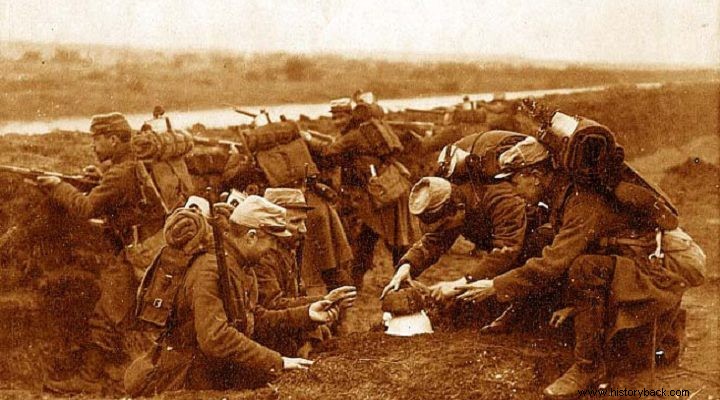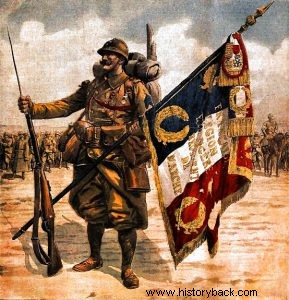
With the outbreak of World War I, the Foreign Legion was forced to reorganize. This was due on the one hand to the large number of German and Austrian legionnaires it included in its ranks and on the other hand to the large number of Americans, Irish and other volunteers (even Greeks), who rushed en masse to join it from the first days of the Great War.
The German and Austrian legionnaires formed the nucleus around which two marching regiments were formed, which were stationed in Morocco. The 1st and 2nd Foreign Regiments remained as a garrison in Algeria, sending a battalion of them to France.
There these battalions formed the nuclei around which two more marching regiments were formed, the Marching Regiment of the 1st Foreign Regiment and the corresponding one of the 2nd Foreign Regiment.
Each regiment had three battalions of young volunteers and one battalion of veterans. These two regiments formed the Legion Brigade, which joined the Moroccan Infantry Division. In October 1914 the Brigade manned a sector of the front in Prunet, where it remained until April 1915. In the meantime, a third marching regiment had been formed, with Russian, Belgian and mainly Italian soldiers, but it was disbanded in March 1915.
His men enlisted in the armies of their countries. Another marching regiment, known as the Garibaldi Brigade, was formed in its place. In its three battalions, in addition to the various volunteers, five relatives of the great Italian revolutionary Garibaldi also served as officers. With the entry of Italy into the war, on the side of ANTATE, the unit was disbanded and its men enlisted in the Italian Army. Until then he had taken part in small operations in the Argonne area, suffering heavy losses.
The Marching Regiment of the 1st Foreign Regiment took part in the major offensive in the Artois region in May 1915. Suffering overwhelming losses, the regiment occupied a 3km zone. of German-occupied territory, which he lost 24 hours later. During this time he had lost 2,200 of his men, out of the 4,000 he initially extended.
For his action this battle flag of the regiment was awarded the Military Cross. The Marching Regiment of the 2nd Foreign Regiment participated on September 27, 1915 in the Battle of Navarin. The regiment suffered 50% losses within two days and was withdrawn to regroup.
Nevertheless, he received honorable mention for the bravery of his men, who, led by a trumpeter, playing the Le Boudin march, charged against the German machine guns, in completely uncovered ground, and overthrew the enemy. The heavy losses suffered by the two regiments forced the French administration to merge them, forming the Marching Regiment of the Foreign Legion (R.M.L.E).
The regiment rejoined the Moroccan Infantry Division (MP), with which it operated throughout the war. He took part in the Battle of the Saône, July 4, 1916, and of Aberyville, April 1917.
In this battle the regiment fought for six days and nights, claiming 2 km of land from the Germans. His losses were heavy. But he succeeded in his mission. for this he was honored by the president of the French Republic himself with the Military Medal, one of France's highest honors.
In August 1917 the Regiment of the Foreign Legion participated in the battle of Coumier, while at the beginning of 1918 it was transferred to Lorraine. It then returned to the Somme front and participated in the repulse of the great German offensive in April 1918 (Operation Michael ).
In the summer of 1918 he was transferred to Soissons to reinforce the hard-pressed French forces. Then, in the fall of 1918, he took part in Marshal Foss's offensive, which forced Germany to capitulate. During the war, 42,883 men from 100 different nations passed through the ranks of the Legion.
Of these more than 30,000 were killed or wounded. This number also includes those serving in the independent battalion of the Legion, which operated initially in Gallipoli and then on the Macedonian Front and against the Bolsheviks, in 1919, in Ukraine.

